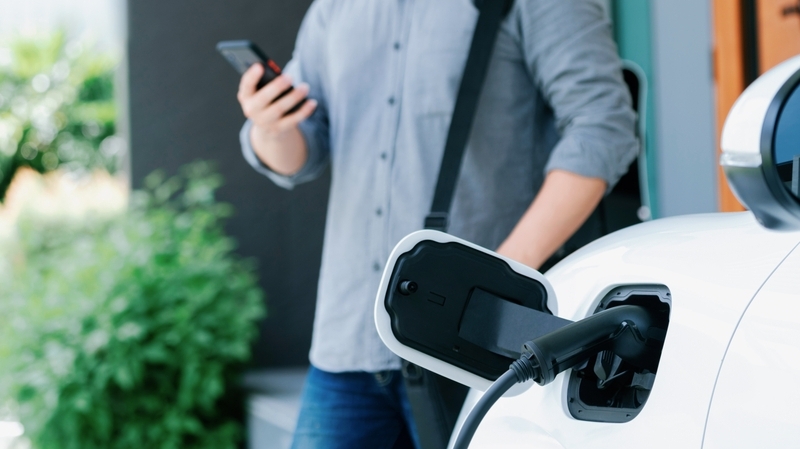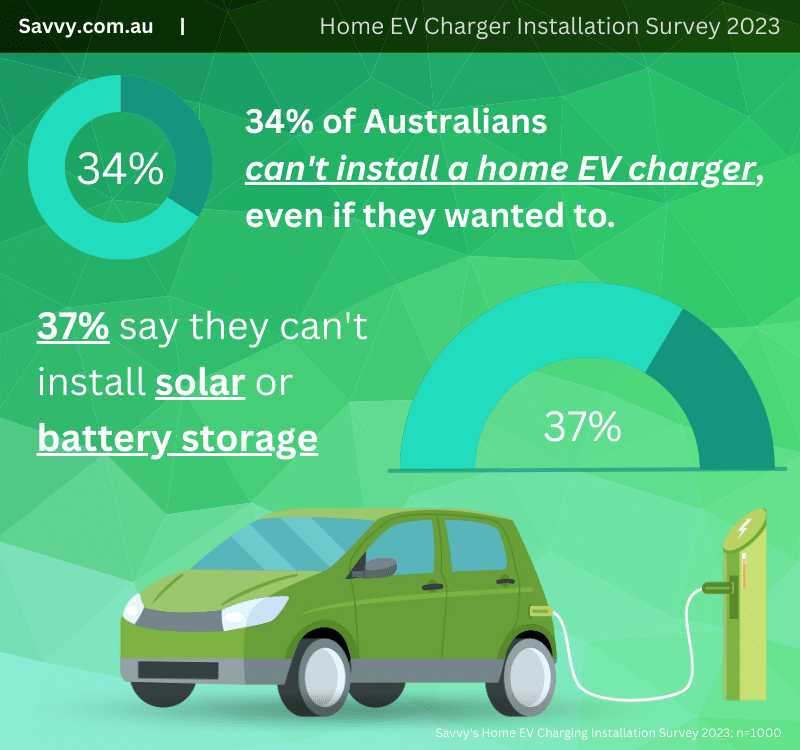
- The Savvy Promise
At Savvy, our mission is to empower you to make informed financial choices. While we maintain stringent editorial standards, this article may include mentions of products offered by our partners. Here’s how we generate income.
In this article
As part of Savvy’s ongoing research into consumer habits in Australia, we take a look at whether EV charging at home is feasible for Australians in 2023.
- 29% of Australians rent and cannot install a home EV charger
- 5% own an apartment not up to the task
- Only 4% live in apartments with option to install a home charger
- 54% of Australians can install EV home chargers at their premises
- 37% of Australians can’t install solar power or battery, even if they wanted to
A representative survey of 1,000 Australians commissioned by Savvy has revealed that 34% of Australians are unable to install electric vehicle (EV) charging at their residence, even if they would like to and at their own expense.
29% of respondents are renting and cannot make substantial alterations to their residence, while 5% of Australians said they live in an apartment or multi-residence complex and are unable to make modifications to allow for EV charging.
38% of the 18–24-year-old cohort said they could not install EV charging at their premises, with 39% of the 25–34-year-old demographic saying the same.
50% of respondents said they own their property and have the option to install EV charging if they so wished. Due to higher rates of home ownership among older demographics, this option was more available to people aged 35 and over.
56% of men and 44% of women said they had the option to install EV charging at their premises.

The double advantage: solar power
54% of Australians either own or can install solar panels and home battery storage on their premises – while 37% of Australians can’t install solar, even if they elected to and at their own expense.
31% of Australians rent and cannot install solar unless their owners decide to invest in it on their behalf. 6% own an apartment, making solar power unfeasible.
The highest proportion locked out of solar power installation were the 18-24s and 25-34s, with 41% of each cohort reporting they could not install solar panels or battery storage units.
Two-thirds (66%) of 65+ Australians reported they either have solar power systems installed or have the option to do so.
Savvy spokesperson Adrian Edlington says that EV charging stations and solar power may be as desirable as outdoor entertaining areas or pool decks when looking for places to live:
“People will want to save money long-term, and having an electric vehicle running on solar power can virtually eliminate two unavoidable living costs, that of fuel and high domestic power prices,” he says.
“Many new higher-density living developments are coming ready equipped with the necessary energy infrastructure and structural reinforcements to accommodate universal EV ownership, meaning the building is strong enough to take the increased weight of a fleet of EVs. On top of that is the improved power infrastructure to allow for residents to install a home EV charger that they pay for. Demand for this is set to grow significantly in coming years and should become an sought-after feature.”
“Those looking to move into or buy property will be asking whether the home already has an EV charging station and or solar panels installed, which could have a significant impact on buyer demand and sale prices.”
“A new kind of inequity has developed though, whereby many Australians are denied the same access to clean technologies, simply because they are renters or reside in dwellings unsuitable for an upgrade.”
What best describes the potential for your home’s car parking space to have a dedicated EV charger installed?
| Total | 1000 | Male (499) | Female (495) | Other (6) | I am currently renting, so unable to install an EV charging station | 29% | 26% | 33% | 17% |
|---|---|---|---|---|
| I own a house / townhouse with the possibility to install a home EV charging station | 50% | 56% | 44% | 33% |
| I own an apartment / unit where it is possible to install a home EV charging station | 4% | 3% | 5% | 17% |
| I own an apartment, though the building infrastructure is not adequate for private EV charging station installation | 5% | 4% | 6% | - |
| None of the above | 11% | 10% | 12% | Yes |
What best describes the potential for your home to have solar panels and a home battery storage unit installed?
| Total | 1000 | Male (499) | Female (495) | Other (6) | I am currently renting, so can’t install solar panels / battery storage unit | 31% | 28% | 34% | 17% |
|---|---|---|---|---|
| I own a house / townhouse where it is possible to install solar / battery storage unit (or have already done so) | 54% | 58% | 50% | 83% |
| I own an apartment - but it's not possible to install solar / battery storage unit, even if I wanted to! | 6% | 5% | 8% | - |
| None of the above | 8% | 9% | 7% | - |
With EV sales soaring, homeowners and renters are looking for residences that have EV charging capability. In our latest survey, 54% of Australians either have home charging installed or have the ability to install it at some point. So how does an Australian homeowner install an EV charger?
How to install an EV charger at home
REMEMBER: Always use a licensed and qualified electrician to perform ANY major electrical work on your home.
Though EV home charger installation is a relatively new service, you should still conduct research into providers of EV home chargers and qualified installers. You may want to check solar panel or inverter installers first, as they are usually familiar with emerging technologies such as EV home charging. When asking about EV home chargers, electricians and other technicians may know them as “Electric Vehicle Supply Equipment” or EVSE. This can prevent confusion or miscommunication.
You also need to check if your home is capable of hosting an EV charger. You will need to see if your home has enough current or electricity flowing into the home to support an EV home charger. Furthermore, you will also need to confirm your meter board has space and an adequate circuit breaker. A licensed electrician can help you modify your connection and meter to ensure an adequate supply.
With all this sorted, you may purchase a charger. Remember to shop around for the best one that suits your needs and configuration.
At this stage, you may need to obtain approval from your State or Territory power authority. Some chargers that exceed 20A single phase or 25A three-phase power may require exemptions.
Once approved, you may engage your licensed and certified electrician to commence the installation. They may need to advise your state or territory power authority that the EV home charger has been installed on your premises.
Home EV charger example pricing chart
| Make | Model | Spec | Phase | App | Mounting | Warranty | Price (installed) | Ocular | LTE Universal | 7.4kW | 1 | - | Indoor / Outdoor | 2 year | $899 |
|---|---|---|---|---|---|---|---|
| Ocular | LTE Universal | 22kW | 3 | - | Indoor / Outdoor | 2 year | $1,100 |
| Ocular | LTE Plus | 7.4kW | 1 | Yes | Indoor / Outdoor | 2 year | $1,180 |
| Ocular | LTE Plus | 22kW | 3 | Yes | Indoor / Outdoor | 2 year | $1,425 |
| Ocular | IQ Solar | 7kW | 1 | Yes | Indoor / Outdoor | 2 year | $1,425 |
| Ocular | IQ Solar | 22kW | 3 | Yes | Indoor / Outdoor | 2 year | $1,989 |
| Kia | Lite | 7.4 kW | 1 | Yes | Indoor / Outdoor | 7 years | $3,192.95 |
| Kia | Max | 22kW | 3 | Yes | Indoor / Outdoor | 7 years | $3,692.57 |
* Figures taken from Evse.com.au & Kia websites, demonstrating cheaper brands vs vehicle brand home chargers.
Ocular brand are compatible with all-electric vehicles and models including: Audi, BMW, BYD, EQC, Holden, Honda, Hyundai, Jaguar, KIA, Mazda, Mercedes Benz, Mini, MG, Mitsubishi, Nissan, Polestar, Porsche, Renault, Rivian, TESLA, Toyota, Volkswagen, Volvo plus more
How much does it cost to install an EV home charger?
EV Home chargers can range in price from about $1,000 to over $3,000, depending on the make or model. You have to ensure that the EV home charger you use is compatible with your electric vehicle (a full EV or Plug In Hybrid) and is either a Level 1 or Level 2 charger – also known as Type 1 or Type 2.
Type 1 chargers are basic AC units and can be plugged into wall mains in your home. They may not require any sophisticated installation (though you should err on the side of caution and use an electrician.)
Type 2 chargers use 240V power and can charge a battery anywhere between five to seven times faster than a Type 1 charger. Type 2 chargers are also the most common type found at public charging stations.
Since they are different types, they will have different plugs and fittings. Make sure you match the right plug to your vehicle.
Installation costs also depend on the level of complexity of the job. Costs can range from $500 to over $5,000. This varies due to a variety of factors.
To learn more about electric vehicle finance, visit our green car loans page here.
Savvy 2024 Car Buying Sentiments Survey; n=1000
Nationally representative survey of 1000 adult Australians, aged 18 and over. Conducted by Octopus Group, on behalf of Savvy.
Completion date: 2/09/2023
Age groups:18-24, 25-34, 35-44, 45-54, 55-64, 65+
Gender breakdown: male n=499, female n=495, non-binary /prefer not to say n=6
Representative of state and territory populations:
NSW n=320 (32.3%), Vic n=252 (25.1%), Qld n=194 (20.2%), SA n=75 (7.2%), WA n=108 (10.6%) NT n=9 (0.7%), Tas n=23 (2.2%), ACT n=19 (1.7%)
Sources:
Did you find this page helpful?
Author
Adrian EdlingtonPublished on August 11th, 2023
Last updated on March 14th, 2024
Fact checked
This guide provides general information and does not consider your individual needs, finances or objectives. We do not make any recommendation or suggestion about which product is best for you based on your specific situation and we do not compare all companies in the market, or all products offered by all companies. It’s always important to consider whether professional financial, legal or taxation advice is appropriate for you before choosing or purchasing a financial product.
The content on our website is produced by experts in the field of finance and reviewed as part of our editorial guidelines. We endeavour to keep all information across our site updated with accurate information.










